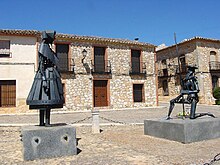This article needs additional citations for verification. (June 2008) |
Dulcinea del Toboso is a fictional character who is unseen in Miguel de Cervantes' novel Don Quixote. Don Quixote believes he must have a lady, under the mistaken view that chivalry requires it.[1]: 117 [2] As he does not have one, he invents her, making her the very model of female perfection: "[h]er name is Dulcinea, her country El Toboso, a village of La Mancha, her rank must be at least that of a princess, since she is my queen and lady, and her beauty superhuman, since all the impossible and fanciful attributes of beauty which the poets apply to their ladies are verified in her; for her hairs are gold, her forehead Elysian fields, her eyebrows rainbows, her eyes suns, her cheeks roses, her lips coral, her teeth pearls, her neck alabaster, her bosom marble, her hands ivory, her fairness snow, and what modesty conceals from sight such, I think and imagine, as rational reflection can only extol, not compare" (Part I, Chapter 13, translation of John Ormsby).
| Dulcinea del Toboso | |
|---|---|
| Don Quixote character | |
 Dulcinea (1957), sculpture by F. Coullaut-Valera, in Madrid (Spain). | |
| Created by | Miguel de Cervantes |
| In-universe information | |
| Gender | Female |
| Family | Lorenzo Gonzalo (father) Aldonza Nogales (mother) |
| Religion | Roman Catholic |
| Nationality | Spanish |
Don Quixote is portrayed as both admirable ("and doth she not of a truth accompany and adorn this greatness with a thousand million charms of mind!" "that, winnowed by her hands, beyond a doubt the bread it made was of the whitest.") and ridiculous throughout the novel. Sancho knows this, and is enthusiastic for Dulcinea in as much as "if your worship goes looking for dainties in the bottom of the sea".[1]
Dulcinea is based on the Spanish word dulce (sweet), and suggests an overly elegant "sweetness". To this day, a reference to someone as one's "Dulcinea" implies idealistic devotion and love for her.[3]

Spurious Part II of the work edit
An unidentified writer using the pseudonym Alonso Fernández de Avellaneda in 1614 published a Part II of Don Quijote.
Although support for Avellaneda's view of Dulcinea is found in Part I of Don Quixote, he has little interest in the glorious, imaginary Dulcinea. Scholars commonly say that because of this and many similar misreadings by Avellaneda, which Cervantes found offensive, he was motivated to complete his own unfinished Part II, which was published the following year. ("...especially my lady the princess Dulcinea, who staggers one's senses." "...who went skipping and capering like goats over the pleasant fields there...")
Opera edit
The Jules Massenet opera Don Quichotte depicts Dulcinée as a major character, the local queen who sends the knight on a quest to retrieve her jewels.[citation needed]
In popular culture edit
- A prostitute named Aldonza is the female lead and identified as "Dulcinea" in Man of La Mancha, an adaptation of the Quixote story, and its subsequent movie adaptation.
- The French composer Maurice Ravel composed Don Quichotte à Dulcinée (1932–33), a cycle of three songs for baritone voice and accompaniment.
- Dulcinea is the female lead in the TV series The Adventures of Puss in Boots.
- Dulcinea appears in the Japanese series Zukkoke Knight – Don De La Mancha. Her real name is Fedora (in the English dub). She is the daughter of the bandit king Poormouth. Her role is to help her bankrupt father by stealing, but she fails almost every time. She fools Don Quixote into helping her. She is voiced by Mami Koyama.[citation needed]
- "Dulcinea" is the title of the first episode of the Syfy television show The Expanse.[4]
See also edit
Notes edit
- ^ a b Eisenberg, Daniel (1987). A Study of "Don Quixote". Juan de la Cuesta. p. 121. ISBN 1588710017.
- ^ Eisenberg, Daniel (2004). "La supuesta homosexualidad de Cervantes". Siglos dorados: Homenaje a Agustín Redondo. Vol. 1. Madrid: Castalia. pp. 399–410. ISBN 849740100X.
- ^ "Dulcinea". oxfordreference.com. Oxford University Press. Retrieved 2020-04-22.
- ^ The Expanse (2015), Episode 1, imdb.com; accessed 1 March 2016.
References edit
- Mancing, Howard (March 2005). "Dulcinea Del Toboso: On the Occasion of Her Four-Hundredth Birthday". Hispania. 88 (1): 53–63. doi:10.2307/20063075. JSTOR 20063075.